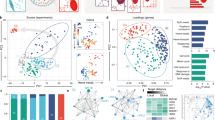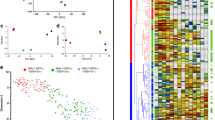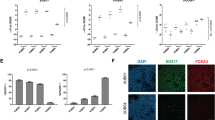Abstract
Populations of cells create local environments that lead to emergent heterogeneity. This is particularly evident with human pluripotent stem cells (hPSCs): microenvironmental heterogeneity limits hPSC cell fate control. We developed a high-throughput platform to screen hPSCs in configurable microenvironments in which we optimized colony size, cell density and other parameters to achieve rapid and robust cell fate responses to exogenous cues. We used this platform to perform single-cell protein expression profiling, revealing that Oct4 and Sox2 costaining discriminates pluripotent, neuroectoderm, primitive streak and extraembryonic cell fates. We applied this Oct4-Sox2 code to analyze dose responses of 27 developmental factors to obtain lineage-specific concentration optima and to quantify cell line–specific endogenous signaling pathway activation and differentiation bias. We demonstrated that short-term responses predict definitive endoderm induction efficiency and can be used to rescue differentiation of cell lines reticent to cardiac induction. This platform will facilitate high-throughput hPSC-based screening and quantification of lineage-induction bias.
This is a preview of subscription content, access via your institution
Access options
Subscribe to this journal
Receive 12 print issues and online access
$259.00 per year
only $21.58 per issue
Buy this article
- Purchase on Springer Link
- Instant access to full article PDF
Prices may be subject to local taxes which are calculated during checkout




Similar content being viewed by others
References
Levenstein, M.E. et al. Basic fibroblast growth factor support of human embryonic stem cell self-renewal. Stem Cells 24, 568–574 (2006).
Bendall, S.C. et al. IGF and FGF cooperatively establish the regulatory stem cell niche of pluripotent human cells in vitro. Nature 448, 1015–1021 (2007).
Vallier, L., Alexander, M. & Pedersen, R.A. Activin/Nodal and FGF pathways cooperate to maintain pluripotency of human embryonic stem cells. J. Cell Sci. 118, 4495–4509 (2005).
Avery, S., Zafarana, G., Gokhale, P.J. & Andrews, P.W. The role of SMAD4 in human embryonic stem cell self-renewal and stem cell fate. Stem Cells 28, 863–873 (2010).
Amit, M. et al. Dynamic suspension culture for scalable expansion of undifferentiated human pluripotent stem cells. Nat. Protoc. 6, 572–579 (2011).
Dahéron, L. et al. LIF/STAT3 signaling fails to maintain self-renewal of human embryonic stem cells. Stem Cells 22, 770–778 (2004).
Sato, N., Meijer, L., Skaltsounis, L., Greengard, P. & Brivanlou, A.H. Maintenance of pluripotency in human and mouse embryonic stem cells through activation of Wnt signaling by a pharmacological GSK-3specific inhibitor. Nat. Med. 10, 55–63 (2004).
Dravid, G. et al. Defining the role of Wnt/β-catenin signaling in the survival, proliferation, and self-renewal of human embryonic stem cells. Stem Cells 23, 1489–1501 (2005).
International Stem Cell Initiative Consortium. et al. Comparison of defined culture systems for feeder cell free propagation of human embryonic stem cells. In Vitro Cell Dev. Biol. Anim. 46, 247–258 (2010).
Peerani, R. et al. Niche-mediated control of human embryonic stem cell self-renewal and differentiation. EMBO J. 26, 4744–4755 (2007).
McBeath, R., Pirone, D.M., Nelson, C.M., Bhadriraju, K. & Chen, C.S. Cell shape, cytoskeletal tension, and RhoA regulate stem cell lineage commitment. Dev. Cell 6, 483–495 (2004).
Maherali, N. & Hochedlinger, K. Guidelines and techniques for the generation of induced pluripotent stem cells. Cell Stem Cell 3, 595–605 (2008).
Chambers, S.M. et al. Highly efficient neural conversion of human ES and iPS cells by dual inhibition of SMAD signaling. Nat. Biotechnol. 27, 275–280 (2009).
Cai, J. et al. Generation of homogeneous PDX1+ pancreatic progenitors from human ES cell-derived endoderm cells. J. Mol. Cell Biol. 2, 50–60 (2010).
Hwang, Y.S. et al. Microwell-mediated control of embryoid body size regulates embryonic stem cell fate via differential expression of WNT5a and WNT11. Proc. Natl. Acad. Sci. USA 106, 16978–16983 (2009).
Sun, N. et al. Patient-specific induced pluripotent stem cells as a model for familial dilated cardiomyopathy. Sci. Transl. Med. 4, 130ra147 (2012).
Xu, C. et al. Feeder-free growth of undifferentiated human embryonic stem cells. Nat. Biotechnol. 19, 971–974 (2001).
Wang, L. et al. Self-renewal of human embryonic stem cells requires insulin-like growth factor-1 receptor and ERBB2 receptor signaling. Blood 110, 4111–4119 (2007).
Xu, R.H. et al. BMP4 initiates human embryonic stem cell differentiation to trophoblast. Nat. Biotechnol. 20, 1261–1264 (2002).
Pera, M.F. et al. Regulation of human embryonic stem cell differentiation by BMP-2 and its antagonist noggin. J. Cell Sci. 117, 1269–1280 (2004).
Vallier, L. et al. Early cell fate decisions of human embryonic stem cells and mouse epiblast stem cells are controlled by the same signalling pathways. PLoS ONE 4, e6082 (2009).
Smith, J.R. et al. Inhibition of Activin/Nodal signaling promotes specification of human embryonic stem cells into neuroectoderm. Dev. Biol. 313, 107–117 (2008).
Vallier, L., Reynolds, D. & Pedersen, R.A. Nodal inhibits differentiation of human embryonic stem cells along the neuroectodermal default pathway. Dev. Biol. 275, 403–421 (2004).
Paige, S.L. et al. Endogenous Wnt/β-catenin signaling is required for cardiac differentiation in human embryonic stem cells. PLoS ONE 5, e11134 (2010).
Vallier, L. et al. Activin/Nodal signalling maintains pluripotency by controlling Nanog expression. Development 136, 1339–1349 (2009).
Lowell, S., Benchoua, A., Heavey, B. & Smith, A.G. Notch promotes neural lineage entry by pluripotent embryonic stem cells. PLoS Biol. 4, e121 (2006).
Boyer, L.A. et al. Core transcriptional regulatory circuitry in human embryonic stem cells. Cell 122, 947–956 (2005).
Mossman, A.K., Sourris, K., Ng, E., Stanley, E.G. & Elefanty, A.G. Mixl1 and Oct4 proteins are transiently co-expressed in differentiating mouse and human embryonic stem cells. Stem Cells Dev. 14, 656–663 (2005).
Chng, Z., Teo, A., Pedersen, R.A. & Vallier, L. SIP1 mediates cell-fate decisions between neuroectoderm and mesendoderm in human pluripotent stem cells. Cell Stem Cell 6, 59–70 (2010).
James, D., Levine, A.J., Besser, D. & Hemmati-Brivanlou, A. TGFβ/activin/nodal signaling is necessary for the maintenance of pluripotency in human embryonic stem cells. Development 132, 1273–1282 (2005).
Wang, G. et al. Noggin and bFGF cooperate to maintain the pluripotency of human embryonic stem cells in the absence of feeder layers. Biochem. Biophys. Res. Commun. 330, 934–942 (2005).
Gonzalez, R. et al. Screening the mammalian extracellular proteome for regulators of embryonic human stem cell pluripotency. Proc. Natl. Acad. Sci. USA 107, 3552–3557 (2010).
Greber, B. et al. Conserved and divergent roles of FGF signaling in mouse epiblast stem cells and human embryonic stem cells. Cell Stem Cell 6, 215–226 (2010).
Vallier, L. et al. Signaling pathways controlling pluripotency and early cell fate decisions of human induced pluripotent stem cells. Stem Cells 27, 2655–2666 (2009).
Yu, P.B. et al. BMP type I receptor inhibition reduces heterotopic ossification. Nat. Med. 14, 1363–1369 (2008).
Nostro, M.C. et al. Stage-specific signaling through TGFβ family members and WNT regulates patterning and pancreatic specification of human pluripotent stem cells. Development 138, 861–871 (2011).
Osafune, K. et al. Marked differences in differentiation propensity among human embryonic stem cell lines. Nat. Biotechnol. 26, 313–315 (2008).
Yang, L. et al. Human cardiovascular progenitor cells develop from a KDR+ embryonic-stem-cell-derived population. Nature 453, 524–528 (2008).
Kattman, S.J. et al. Stage-specific optimization of activin/nodal and BMP signaling promotes cardiac differentiation of mouse and human pluripotent stem cell lines. Cell Stem Cell 8, 228–240 (2011).
Bock, C. et al. Reference Maps of human ES and iPS cell variation enable high-throughput characterization of pluripotent cell lines. Cell 144, 439–452 (2011).
Snijder, B. et al. Population context determines cell-to-cell variability in endocytosis and virus infection. Nature 461, 520–523 (2009).
Hussein, S.M. et al. Copy number variation and selection during reprogramming to pluripotency. Nature 471, 58–62 (2011).
Amps, K. et al. Screening ethnically diverse human embryonic stem cells identifies a chromosome 20 minimal amplicon conferring growth advantage. Nat. Biotechnol. 29, 1132–1144 (2011).
Hotta, A. et al. Isolation of human iPS cells using EOS lentiviral vectors to select for pluripotency. Nat. Methods 6, 370–376 (2009).
Cheung, A.Y. et al. Isolation of MECP2-null Rett Syndrome patient hiPS cells and isogenic controls through X-chromosome inactivation. Hum. Mol. Genet. 20, 2103–2115 (2011).
Peerani, R., Bauwens, C., Kumacheva, E. & Zandstra, P.W. Patterning mouse and human embryonic stem cells using micro-contact printing. Methods Mol. Biol. 482, 21–33 (2009).
Seki, T., Yuasa, S. & Fukuda, K. Generation of induced pluripotent stem cells from a small amount of human peripheral blood using a combination of activated T cells and Sendai virus. Nat. Protoc. 7, 718–728 (2012).
Bauwens, C.L. et al. Geometric control of cardiomyogenic induction in human pluripotent stem cells. Tissue Eng. Part A 17, 1901–1909 (2011).
Rezania, A. et al. Maturation of human embryonic stem cell-derived pancreatic progenitors into functional islets capable of treating pre-existing diabetes in mice. Diabetes 61, 2016–2029 (2012).
Acknowledgements
This work is funded by the Canadian Institutes of Health Research (CIHR) (P.W.Z.). E.J.P.N. is supported by a CIHR Frederick Banting and Charles Best Canada Graduate Scholarships Doctoral Award. P.B.L. is supported by a Heart & Stroke Richard Lewar Centre of Excellence Studentship award. S.S. is supported by a Vanier Canada Graduate Scholarship. P.W.Z. is supported as the Canada Research Chair in Stem Cell Bioengineering. We thank S. Foster for illustrating Supplementary Figure 1. Ligands were provided in kind by the International Stem Cell Initiative. We thank G. Keller (McEwen Centre for Regenerative Medicine/University Health Network), M. Radisic (University of Toronto), A. Nagy (Samuel Lunenfeld Research Institute), D. Melton (Harvard University), A. Elefanty (Monash University) and J. Ellis (The Hospital for Sick Children) for providing cell lines. We thank P. Andrews and M. Pera for helpful discussion.
Author information
Authors and Affiliations
Contributions
E.J.P.N. designed, performed and analyzed most experiments. J.E.E.O. assisted with immunocytochemistry and software development. P.B.L. performed cardiac induction experiments. S.S. created hiPSC lines. T.Y. performed endoderm induction experiments. M.M.A. and T.Y. provided cell culture support. S.K.W.O. provided editorial input on the manuscript. E.J.P.N. and P.W.Z. designed the project and wrote the manuscript.
Corresponding author
Ethics declarations
Competing interests
The authors declare no competing financial interests.
Supplementary information
Supplementary Text and Figures
Supplementary Figures 1–10, Supplementary Table 1 and Supplementary Results (PDF 1736 kb)
Rights and permissions
About this article
Cite this article
Nazareth, E., Ostblom, J., Lücker, P. et al. High-throughput fingerprinting of human pluripotent stem cell fate responses and lineage bias. Nat Methods 10, 1225–1231 (2013). https://doi.org/10.1038/nmeth.2684
Received:
Accepted:
Published:
Issue Date:
DOI: https://doi.org/10.1038/nmeth.2684
This article is cited by
-
Induced Pluripotent Stem Cells (iPSCs) Provide a Potentially Unlimited T Cell Source for CAR-T Cell Development and Off-the-Shelf Products
Pharmaceutical Research (2021)
-
Microtechnology-based methods for organoid models
Microsystems & Nanoengineering (2020)
-
Dynamic intercellular transport modulates the spatial patterning of differentiation during early neural commitment
Nature Communications (2018)
-
Stem cell bioengineering: building from stem cell biology
Nature Reviews Genetics (2018)
-
Controlling the Interfacial Chemical and Physical Properties for Stem Cell Culture
Topics in Catalysis (2018)



